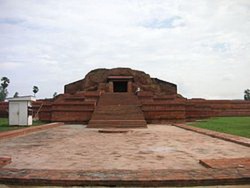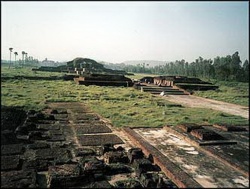Vikramaśīla
From about the 8th or 9th centuries onwards a new type of Buddhism began to develop in India which later became known as the Vajrayāna, the last of the three great `vehicles' of Buddhism. In the beginning this new interpretation met with disapproval amongst the more traditional monks and nuns, so King Dharmapāla (775-812) founded a monastery named Vikramaśīla especially for its study. One Tibetan source gives us this description of the monastery. `Sri Vikramaśīla was built on the bank of the Ganges in the north of Magadha on the top of a hill. At its centre was built a temple housing a life-size copy of the Mahābodhi image. Around this were fifty three small temples for the study of the Guhyasamāja Tantra and another fifty four ordinary ones, all being surrounded by a wall. Thus the number of temples was one hundred and eight. He (Dharmapāla) also provided requisites for one hundred and eight pundits.' From other sources we also know that there was a huge courtyard big enough to hold 8,000 monks, that at the entrance to the main temple were two statues, one of Nāgārjuna and another of Atisa, and that the monastery's perimeter wall had six gates. At the main entrance there was a dharmasāla to accommodate those who arrived after the gates had been locked at night. What the monastic universities at Valabhī and Bodh Gayā were to early Buddhism and Nāḷandā was to Mahāyāna, Odantapuri and Vikramaśīla were to Varjayāna. Some of the monasteries `gate keeper scholars' were amongst the greatest names of this twilight period of Indian Buddhism. They included Santipa, Jetari, Ratnavajira, Jñanasrimitra and the great Naropa. Vikramaśīla's first abbot, Buddhajñanapada, was the author of some 14 works and was described as `a great pundit learned in many fields of knowledge.' The monastery's greatest son however was the Bengali monk Atisa (982-1054). Apart from being a brilliant scholar and prolific writer, he also developed a new curriculum for the university, built more rooms for its monks and invited some of the best pundits of the time to come and teach there. The colophons on several of Atisa's works state that he wrote then ‘while residing at Sri Vikramaśīla Mahāvihāra.'
its height during the reign of King Rāmapāla at the beginning of the 11th century there were 160 teachers and 1,000 students. They are known to have come from all over north India as well as from Kashmir, Java, Nepal and Tibet. Vikramaśīla's connection with Tibet is of course well known, its connection with Sri Lanka less so. However, Vajrayàna flourished in Sri Lanka for about 300 years and teachers from Vikramaśīla were sometimes invited to the island. The Caturasitisiddhapravritti says that Santipa, one of the greatest of the legendary 84 siddhas and a teacher at Vikramaśīla, visited Sri Lanka at the invitation of the country's king and stayed for three years. Nor was the movement one way, Lankajayabadhra, famous for his expositions of the Guhayasamàja Tantra was one of the great Sri Lankan Tantric scholars who taught at the monastery. Some Tantric practitioners had a bad reputation for unconventional behavior, but such things were not tolerated at Vikramaśīla. It is recorded that a monk named Maitrigupta was expelled for bringing wine into the monastery. As was the custom, he was ejected over the wall rather than being allowed to leave through the main gate.
At the beginning of the 13th century Vikramaśīla met the same fate as all Buddhist centres in India. One Tibetan source says that the monk Prajnarakshita prayed to a Tantric deity and the Muslim soldiers who were about to attack Vikramaśīla were scattered by a great rain storm. The reality was rather different. As the invading armies pushed further east, the king hastily fortified several of the larger monasteries including Vikramaśīla and stationed soldiers in them. But it did no good. In about 1206 Vikramaśīla was sacked, its inmates were killed or driven away and its foundation stone was tossed into the Ganges. Towards the end of the 19th century European and Indian scholars began speculating about where Vikramaśīla might be. In 1901 Nundalal Dey suggested that it might be at Patharaghat where there were several huge mounds and fragments of Buddhist statuary near a hill overlooking the Ganges. One ancient Tibetan source says that the monastery was situated ‘where the holy river flows northward' and indeed the Ganges does turn north at Patharaghat. Although Dey's suggestion is now widely accepted as correct, excavations at Patharaghat have so far failed to find a single inscription or seal actually mentioning the name Vikramaśīla.

